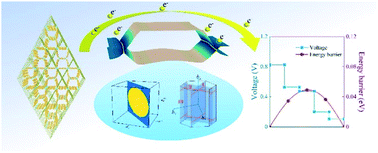Design of 3D topological nodal-net porous carbon for sodium-ion battery anodes
Abstract
Based on first-principles calculations, we propose a new 3D topological nodal-net carbon allotrope consisting of graphene nanoribbons. This structure possesses orthorhombic symmetry with 46 carbon atoms in its primitive cell, termed oC46, which is energetically, thermally, and dynamically stable. More interestingly, a Dirac nodal net composed of three types of nodal lines is found in its first Brillouin zone, where the nodal lines are protected by the coexistence of time-reversal, spatial inversion, and mirror/glide-plane symmetries. These features can be characterized by effective k·p models. In addition, oC46 is found to be a promising anode material for sodium-ion batteries with a high reversible capacity of 303 mA h g−1, a low diffusion energy barrier (0.05 eV) for Na ions, an appropriate average voltage of 0.43 V, and a small volume change of 2.0% during charging/discharging operation. The main reasons for the high performance are uncovered to be due to the ordered porosity of the structure and the Dirac massless fermions induced by the nodal net, which provide a large number of sodium-ion adsorption sites and enhance the electric conductivity of both electrons and ions. These findings make this system promising for Na-ion batteries.



 Please wait while we load your content...
Please wait while we load your content...